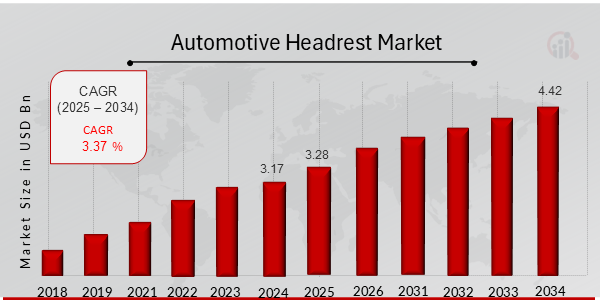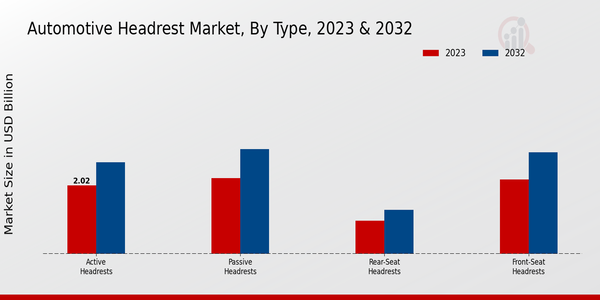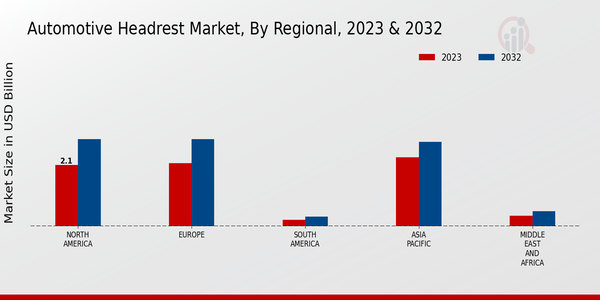Global Automotive Headrest Market Overview
As per MRFR analysis, the Automotive Headrest Market Size was estimated at 3.17 (USD Billion) in 2024. The Automotive Headrest Market Industry is expected to grow from 3.28 (USD Billion) in 2025 to 4.42 (USD Billion) till 2034, at a CAGR (growth rate) is expected to be around 3.37% during the forecast period (2025 - 2034).
Key Automotive Headrest Market Trends Highlighted
Key market drivers in the automotive headrest market include increasing demand for comfort and safety features, technological advancements in headrest design, and rising disposable income in emerging economies. Opportunities are presented by the integration of smart technologies into headrests, such as infotainment systems and health monitoring capabilities. Recent trends reveal a shift towards customizable headrests that cater to diverse ergonomic needs, as well as a growing adoption of active headrests that enhance safety during collisions. Additionally, the automotive headrest market is poised to benefit from increasing demand for luxury vehicles and the proliferation of advanced driver-assistance systems (ADAS).

Source: Primary Research, Secondary Research, MRFR Database and Analyst Review
Automotive Headrest Market Drivers
Increasing Demand for Enhanced Comfort and Safety Features
The rising demand for enhanced comfort and safety features in automobiles is a major driver of the Automotive Headrest Market growth. As consumers become more aware of the importance of ergonomics and safety, they are increasingly opting for vehicles equipped with comfortable and supportive headrests. Headrests play a crucial role in reducing the risk of whiplash injuries during rear-end collisions by providing proper support to the head and neck. Additionally, manufacturers are focusing on developing innovative headrest designs that offer adjustable lumbar support and advanced cushioning materials to enhance overall comfort during long journeys.
Growing Prevalence of Luxury and Premium Vehicles
Another trend driving the growth of the automotive headrest market in the global arena is the increasing popularity of luxury and premium vehicles. Usually, luxury cars are made with high-quality and feature-rich headrests that provide users with great comfort and support. As such, with the increasing number of people using high-end vehicles, the need for advanced headrest systems is projected to grow considerably. In addition, the increasing preference for sports utility vehicles and crossover cars that come with larger and comfort-enhancing interiors also has an overall positive impact on the expansion of the automotive headrest market.
Technological Advancements and Innovation
Rapid technological advancements and innovation in the automotive industry are also driving the growth of the Automotive Headrest Market. Manufacturers are continually developing new headrest systems that incorporate advanced features such as active noise cancellation, massage functions, and built-in entertainment systems. These innovative headrests enhance the overall driving experience and provide additional comfort and convenience to passengers. Furthermore, the integration of advanced materials and lightweight designs is enabling the development of headrests that are both durable and aesthetically pleasing.
Automotive Headrest Market Segment Insights:
Automotive Headrest Market Type Insights
The Automotive Headrest Market is segmented by Type into Active Headrests, Passive Headrests, Rear-Seat Headrests, and Front-Seat Headrests. Among these segments, Active Headrests held the largest market share in 2023 and is expected to continue its dominance throughout the forecast period. This growth can be attributed to the increasing demand for enhanced safety features in vehicles. Active headrests are designed to move forward in the event of a rear-end collision, reducing the risk of whiplash injuries.
Passive Headrests, on the other hand, are fixed in place and provide support for the head and neck in the event of a collision. They are typically found in older vehicles and are less effective than active headrests in preventing whiplash injuries. Rear-seat headrests are designed to protect the heads and necks of rear-seat passengers in the event of a collision. They are becoming increasingly common in new vehicles as manufacturers prioritize the safety of all occupants.
Front-seat headrests are designed to protect the heads and necks of front-seat passengers in the event of a collision. They are typically adjustable to accommodate different heights and positions. The Automotive Headrest Market is expected to grow at a steady pace in the coming years, driven by increasing consumer demand for safety features and rising vehicle production.

Source: Primary Research, Secondary Research, MRFR Database and Analyst Review
Automotive Headrest Market Mechanism Insights
The Automotive Headrest Market is segmented by Mechanism into Manual Headrests, Adjustable Headrests, and Electric Headrests. Manual Headrests accounted for the largest share of the market in 2023, owing to their low cost and ease of use. Adjustable Headrests are expected to witness the highest growth over the forecast period due to their increasing popularity among consumers. The increasing demand for vehicles with enhanced safety features is driving the growth of the Manual Headrests market. The Automotive Headrest Market for Adjustable Headrests was valued at USD 2.97 billion in 2023 and is projected to reach USD 4.0 billion by 2032, exhibiting a CAGR of 3.37%. The growing popularity of luxury vehicles is propelling the growth of the Electric Headrests market.
Automotive Headrest Market Material Insights
The Material segment of the Automotive Headrest Market is expected to witness significant growth in the coming years, driven by rising demand for premium and comfortable automotive interiors. Fabric headrests, the largest segment, are projected to hold a dominant market share owing to their affordability, breathability, and wide range of customization options. Leather headrests, known for their luxurious appeal and durability, are expected to grow steadily as consumers seek a more premium driving experience. Synthetic leather headrests offer a cost-effective alternative to genuine leather, providing similar aesthetics and comfort at a lower price point.Carbon fiber headrests, while still a niche segment, are gaining popularity in high-performance and racing vehicles due to their lightweight and durability. Overall, the increasing preference for personalized and comfortable automotive interiors is driving growth in the Material segment of the Automotive Headrest Market, with various materials catering to diverse consumer needs and preferences.
Automotive Headrest Market End-Use Insights
The end-use segment of the Automotive Headrest Market is categorized into Passenger Cars, Commercial Vehicles, and Off-Road Vehicles. Passenger Cars hold the dominant market share due to the increasing production and sales of passenger vehicles globally. In 2023, the Passenger Cars segment accounted for around 65% of the Automotive Headrest Market revenue, which is estimated to reach USD 3.2 billion by 2027, exhibiting a CAGR of 3.5%. Commercial Vehicles are projected to witness steady growth owing to the rising demand for last-mile delivery services and e-commerce logistics.Off-road vehicles, including SUVs, ATVs, and UTVs, are gaining popularity due to their versatility and off-road capabilities, contributing to the growth of the Automotive Headrest Market.
Automotive Headrest Market Regional Insights
The regional segmentation of the Automotive Headrest Market presents diverse market dynamics and growth opportunities. North America holds a significant market share due to the presence of major automotive manufacturers and high consumer demand for comfort and safety features. Europe follows closely, driven by stringent safety regulations and a growing preference for premium vehicles. APAC is projected to witness substantial growth over the forecast period, fueled by rising vehicle production and increasing disposable incomes. South America and MEA, while having smaller market shares, are expected to exhibit steady growth due to expanding automotive industries and improving economic conditions.These regions offer lucrative opportunities for market players to cater to the growing demand for automotive headrests, particularly in emerging markets.

Source: Primary Research, Secondary Research, MRFR Database and Analyst Review
Automotive Headrest Market Key Players And Competitive Insights:
Major players in the Automotive Headrest Market industry are constantly engaged in research and development to offer innovative products and enhance their market presence. Leading Automotive Headrest Market players focus on developing technologically advanced headrests with features such as adjustable lumbar support, memory foam cushioning, and integrated massage functions. They also invest in collaborations and partnerships to expand their product portfolio and cater to diverse customer needs. The Automotive Headrest Market development is driven by the increasing demand for enhanced comfort and safety features in automobiles.
Competitive strategies include strategic partnerships, mergers and acquisitions, and geographical expansion to gain a competitive advantage.Aisin Seiki Co., Ltd. is a leading player in Automotive Headrest Market industry. With a global presence and a wide product range, the company caters to various vehicle segments. Aisin Seiki focuses on innovation and quality, offering headrests with advanced ergonomic designs, adjustable headrest height and angle, and lumbar support systems. The company's strong manufacturing capabilities and extensive distribution network contribute to its competitive edge.
Lear Corporation is a notable competitor in the Automotive Headrest Market, renowned for its comprehensive automotive seating solutions. The company offers a wide range of headrests designed to enhance comfort, safety, and aesthetics. Lear Corporation leverages its global manufacturing footprint and technical expertise to deliver customized headrests that meet specific vehicle requirements. The company's focus on sustainability and lightweight materials aligns with the evolving industry trends, contributing to its competitive positioning.
Key Companies in the Automotive Headrest Market Include:
- Aunde
- Recaro
- Johnson Controls
- TS Tech
- Martinrea International
- Interiors
- Faurecia
- Adient
- Huf
- Magna
- Heller
- Yanfeng
- Lear
- Delphi Technologies
- Kongsberg
Automotive Headrest Market Industry Developments
The automotive headrest market is witnessing significant growth, driven by increasing consumer demand for safety and comfort, as well as government regulations mandating their use. In 2025, the market was valued at 3.28 billion USD and is projected to reach 4.42 billion USD by 2034, exhibiting a CAGR of 3.37%. The market is witnessing the emergence of advanced headrests, such as active headrests, that provide additional support and protection in the event of a collision.
Additionally, the growing popularity of electric vehicles is expected to drive demand for headrests with integrated electronics and connectivity features. Key players in the market include Lear Corporation, Magna International, and Adient. Recent developments include the introduction of headrests with built-in speakers and massage functions, as well as the integration of sensors for driver monitoring systems.
Automotive Headrest Market Segmentation Insights
Automotive Headrest Market Type Outlook
- Active Headrests
- Passive Headrests
- Rear-Seat Headrests
- Front-Seat Headrests
Automotive Headrest Market Mechanism Outlook
- Manual Headrests
- Adjustable Headrests
- Electric Headrests
Automotive Headrest Market Material Outlook
- Fabric Headrests
- Leather Headrests
- Synthetic Leather Headrests
- Carbon Fiber Headrests
Automotive Headrest Market End Use Outlook
- Passenger Cars
- Commercial Vehicles
- Off-Road Vehicles
Automotive Headrest Market Regional Outlook
- North America
- Europe
- South America
- Asia Pacific
- Middle East and Africa
| Report Attribute/Metric |
Details |
|
Market Size 2024
|
3.17 (USD Billion)
|
|
Market Size 2025
|
3.28 (USD Billion)
|
|
Market Size 2034
|
4.42 (USD Billion)
|
|
Compound Annual Growth Rate (CAGR)
|
3.37% (2025 - 2034)
|
|
Report Coverage
|
Revenue Forecast, Competitive Landscape, Growth Factors, and Trends
|
|
Base Year
|
2024
|
|
Market Forecast Period
|
2025 - 2034
|
|
Historical Data
|
2019 - 2023
|
| Market Forecast Units |
USD Billion |
| Key Companies Profiled |
Aunde, Recaro, Johnson Controls, TS Tech, Martinrea International, Interiors, Faurecia, Adient, Huf, Magna, Heller, Yanfeng, Lear, Delphi Technologies, Kongsberg |
| Segments Covered |
Type, Mechanism, Material, End Use, Regional |
| Key Market Opportunities |
Growing demand for luxury vehicles Rising adoption of advanced safety features Increasing focus on passenger comfort Integration of entertainment systems Technological advancements |
| Key Market Dynamics |
Rising emphasis on safety, growing demand for comfort and luxury technological advancements increasing disposable income, and stringent government regulations |
| Countries Covered |
North America, Europe, APAC, South America, MEA |
Frequently Asked Questions (FAQ) :
The Automotive Headrest Market is anticipated to reach an overall valuation of 3.28 billion USD in 2025.
The Automotive Headrest Market is projected to grow at a CAGR of 3.37% from 2025 to 2034.
The Automotive Headrest Market is projected to reach 4.42 billion USD by 2034.
North America is expected to account for the largest market share in the Automotive Headrest Market during the forecast period.
The passenger cars segment is expected to hold the largest market share in the Automotive Headrest Market.
Key players in the Automotive Headrest Market include Adient, Lear Corporation, Faurecia, Magna International, and Toyota Boshoku.
Rising demand for enhanced comfort and safety features in vehicles is driving the growth of the Automotive Headrest Market.
Fluctuating raw material prices and intense competition pose challenges to the growth of the Automotive Headrest Market.
Growing demand for luxury vehicles and increasing awareness of safety regulations present opportunities for growth in the Automotive Headrest Market.
Factors to consider when choosing an automotive headrest include comfort, adjustability, safety features, and compatibility with the vehicle.

















